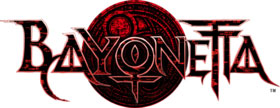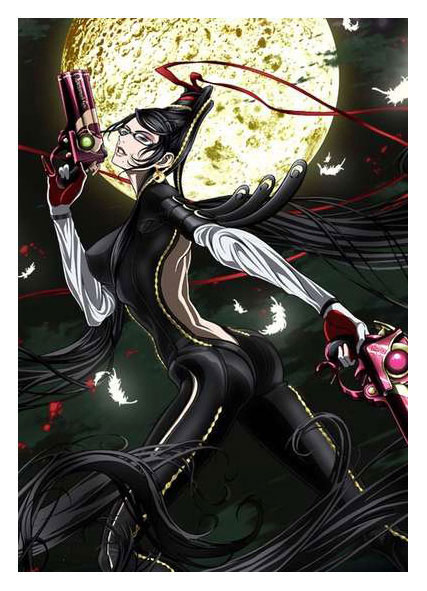Most of the animation students at my college prefer anime to “traditional,” Western animation—a puzzling phenomenon given the massive distribution of the Disney franchise, as well as Loony Tunes and its many spinoffs, but evident with only a cursory glance through senior portfolios and art projects.
Then again, both my boys grew up trading Yugioh cards and watching Pokemon. So, the Japanese influence in the American youth market has been profound for a couple generations now in the way Bruce Lee’s martial art films were in my own. The appeal of the exotic, and the appeal of the warrior perhaps. Anime goes where traditional animation does not. It blends Eastern spirituality, medieval war culture, and visual dazzle. And it addresses adult subjects. Such is the case with Bayonetta: Bloody Fate (2013), a complex adaptation of a popular video game that brings the visual excess and dizzying action of the game to the screen, while catering to mature tastes.

Anime or not, the Bayonetta story is familiar in its larger pattern within the comic book/adventure genre. The lead character is a misunderstood outsider hero destined to face off with an evil genius threatening an apocalypse. In the climactic scene the hero will have one final bullet in the gun, one last option, and… The Hobbit comes to mind as prototype where Bard has one final black arrow to use against Smaug the dragon, and a little thrush whispers in his ear where Smaug’s vulnerable patch is, and twang. A benevolent Providence saves the day.
Bayonetta is one of the last Umbran Witches. She daily battles against super-powerful “angels” (who are really the opposite) in a surreal universe of blended mythologies. She fights in a swirling ring of excess against video-game adversaries, firing away with a ramped up pair of six-shooters worthy of Shane channeled through the Green Lantern. And she is eye candy, drawn as buxom and alluring with ankle-length hair flowing around an outfit that gets more revealing as the narrative unfolds.
Five hundred years before the story begins, the Lumen Sages and Umbra Witches lived in harmony until one of the former had a child with one of the latter. Bayonetta, an Umbra Witch, is that child, and she is in search of the true meaning of her past. Unfortunately, a significant part of that past is an evil wizard of sorts with a plan for a new world order, the kind that begins with the annihilation of the old order first. Always a rub.

The movie begins with a sequence of stunning visuals as the mysterious Bayonetta wipes out a group of “angels” in a beautifully rendered Gothic cathedral while being photographed by the man who will of course become her love interest, the hunky Luka. The sequence is interesting on several levels because of the contradictions in form and multiple vantage points, not the stuff of Disney.
Unique in the experience of watching Bayonetta is its video game pacing, and that the movie does not allow for the interaction of playing the actual video games. So, in the game when concepts are taken to logical extremes—the hero climbing gigantic demons while blasting away the enemy, flying through the sky on a motorcycle, and shooting rows of beasts like ducks at a carnival—you at least have controls in your hands that allow some release of tension. With the movie you are forced to sit on the bench watching the game flow past and all around. It’s a little like watching your brother play pinball from the side of the machine. Almost dizzying.
I am told that the movie means more when you know the characters, which makes sense, especially as the cast of the movie is minimal, one of the common features of anime. The world they inhabit is a type of Danteesque Inferno, all the characters being extreme types, though without the guide inquiring of the damned souls who pause to offer their history. Here you mostly guess.
The animation in Bayonetta: Bloody Fate is extremely compelling. Two and three-dimensional animation techniques intermingle with surprising beauty in parts. The action sequences are fluid. The set design is high-end, most notably in the beautiful stained-glass window iconography juxtaposed against the blood-spray carnage of the opening scene.
Then there is the fact that the lead character actually succeeds as pure male eye candy. On one level Bayonetta the movie serves as a burlesque backdrop for gazing at the lead character in various stages of dress and undress, an odd thing to say about what we used to refer to as a cartoon character, but true. In one “money shot” the “witch” steps out of a shower with only her hair to cover, flaunting her assets in the way of an old Gil Elvgren pinup.
And finally there is a curious depth to the question the movie raises about divine will. When does heaven cross the line for the sake of the large-scale plan? This is implied in the final confrontation between Bayonetta and the “evil genius.” It seems a question a Japanese agnostic may ask a Western Christian. And the answer is not a single Bible verse.
Perhaps this contributes to the phenomenon I referenced at the start, the popularity of anime among the younger generation. Perhaps our answers have been too shallow?
